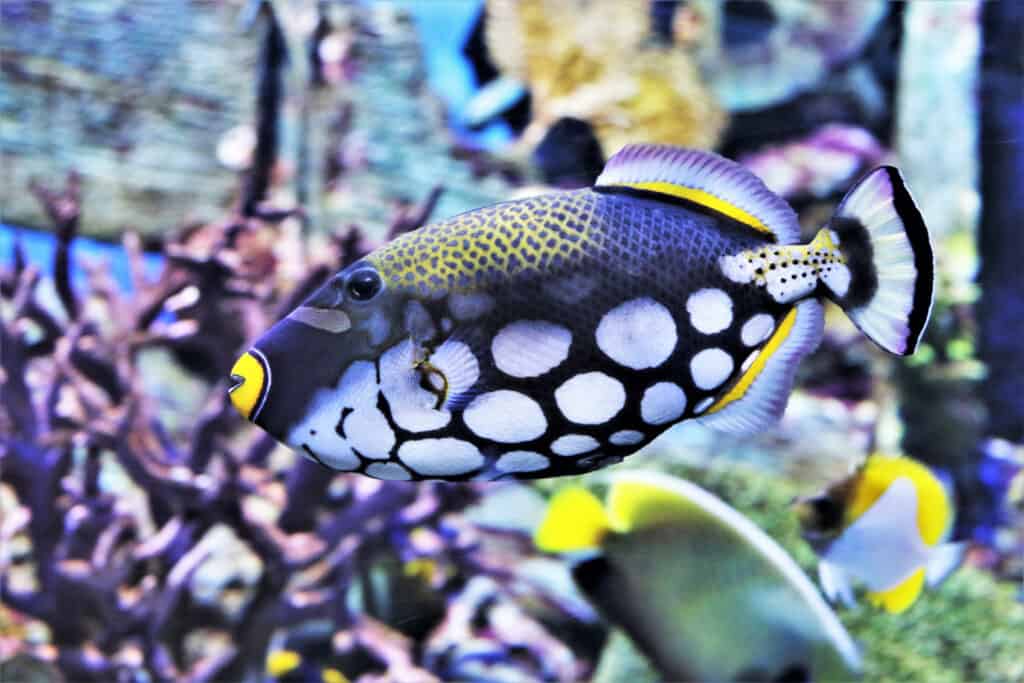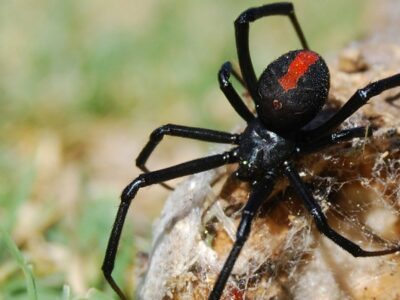Triggerfish
There are 40 species of Triggerfish, all with different coloring and patterns.
Advertisement
Triggerfish Scientific Classification
Read our Complete Guide to Classification of Animals.
Triggerfish Conservation Status
Triggerfish Facts
- Prey
- Mollusks, crustaceans, urchins
- Group Behavior
- Solitary
- Fun Fact
- There are 40 species of Triggerfish, all with different coloring and patterns.
- Biggest Threat
- Loss of habitat
- Most Distinctive Feature
- They can lock the spines of their fins, then unlock like a "trigger."
- Temperament
- They are very protective of their eggs.
- Habitat
- Reef and shallow water
- Predators
- Sharks
- Diet
- Omnivore
- Favorite Food
- Urchins, crustaceans, mollusks
- Number Of Species
- 40
- Location
- Tropical waters
View all of the Triggerfish images!
Triggerfish can lock the spines of their fins, then unlock like a “trigger.”
If it is a Triggerfish, chances are they came from a tropical reef. These fish exhibit interesting colors and shapes, including spots, stripes, and bands. They are also very protective of their eggs and can even get aggressive with scuba divers and snorkelers that get too close. Some species also make a great meal, with a firm white flesh that works in a variety of cooking styles.
Facts
- These fish have been known to attack and even bite people and other animals that get too close to their eggs.
- Because of their bright colors and fun shapes, Triggerfish are popular in aquariums.
- The largest species of Triggerfish can grow over 3 feet long.
- Only one species within the Triggerfish family is unsafe to eat, the Clown Triggerfish. Interestingly, this is one of the most popular aquarium fish due to its color and pattern.
- Edible species of Triggerfish are compared to crab meat.
Classification and Scientific name
Triggerfish does not just refer to one species of fish. It actually includes 40 species that are all part of the Balistidae family. They are all brightly colored tropical fish and often have lines, spots, and multiple colors on their scales.
The Balistidae family is part of the Tetraodontiformes order. They are also sometimes referred to as Plectognathi, or as a suborder of the Perciformes. They are all ray-finned fish, which means that their fins are actually made of skin that is supported by rays made of bone. Triggerfish belong to the Actinopterygii class. This class includes more than half of all known vertebrate species. They are part of the Chordata phylum and Animalia kingdom.
Triggerfish Species
There are 12 genera within the Balistidae family of Triggerfish and 40 species. One of the most recognizable is the Clown Triggerfish, Balistoides conspicillum. It is black and yellow with distinctive white spots on its belly. Other species include the Stone Triggerfish, Pseudobalistes naufragium, which can grow up to 3 feet in length.
The Gray Triggerfish, Balistes capriscus, is one of the less colorful species. As its name suggests, it is gray in color. This helps it blend into its environment. It can adjust its color to help camouflage itself even better. It is a popular fish for aquariums and is also quite tasty when cooked.
Triggerfish Appearance
All of the species of Triggerfish vary in their coloring and appearance, but do share some similarities. Generally, they have oval bodies and narrow snouts. They are more flat than round, made more noticeable by the high placement of their eyes. Triggerfish also have strong teeth and jaws.
They have three dorsal fins that are further back on their body, two fused pelvic fins, and a caudal fin. All of their fins are supported by bony rays, just like other ray-finned fish. They use these spines to lock themselves into holes or other places to hide from predators. When the coast is clear, they release a “trigger” to unlock their spines and swim away.
While many Triggerfish are brightly colored, they do not all share the same coloring or even pattern features. Spots and lines are common in the various species, which makes them very popular for aquariums. Two of the most notable species include the Clown Triggerfish and the Lagoon Triggerfish. While the Clown Triggerfish has large spots on its belly, the Lagoon Triggerfish has an all-white belly with black and white stripes on the end of its body. It also has fluorescent green markings near its eyes.
The Stone Triggerfish is the largest species, growing up to 3 feet or more. But most Triggerfish are between 8 and 20 inches. This is still a large fish, especially considering its brilliant coloring. When kept in an aquarium, it makes a notable statement.

The vibrant colors of the triggerfish can also act as camouflage, helping them blend into the background.
©Arunee Rodloy/Shutterstock.com
Distribution, Population, and Habitat
Most species of Triggerfish enjoy safe habitats and adequate population numbers in the wild. They are often found living in or near reefs, especially in tropical and subtropical waters. They favor shallower water to be able to eat plenty of mollusks and crustaceans. Some species do live in the deeper Ocean, however, including the Ocean Triggerfish. It has longer fins than other Triggerfish to help in its environment.
The Gray Triggerfish is considered a sustainable fish by the National Oceanic and Atmospheric Administration. Also known as a Leatherjacket, Leatherneck, or Taly, it is also one of the tastiest varieties of Triggerfish.
The Queen Triggerfish is listed as vulnerable on the International Union for Conservation of Nature list. While it is not endangered, it could become endangered if its numbers continue to decline. Overfishing and loss of habitat are two factors that impact the population of all Triggerfish but especially those that are being monitored for conservation.
Triggerfish Predators and Prey
Larger fish eat Triggerfish. These can include sharks, tuna, marlin, and grouper. The larger species of Triggerfish may be too big for small predators to take on. Triggerfish can also get very aggressive, especially when it comes to protecting their eggs. Not only will they attack potential predators, they will also go after any other fish and even scuba divers that get too close to their eggs.
Many species of Triggerfish favor mollusks, crustaceans, and urchins. They often target slow-moving creatures or those that don’t move at all. They use their strong teeth and jaws to bite into the shells and protective coverings of their preferred food. Some species do eat algae and others eat plankton. Just like within any family, each species has its own preferences. These are often based on their environment and what they evolved to eat.
Triggerfish Reproduction and Lifespan
One of the most interesting behaviors that Triggerfish exhibit is their fiercely protective nature. Triggerfish can get very aggressive, biting and attacking other creatures that get too close to their eggs. After competing for mates, they lay their eggs on the sandy bottom part of the ocean floor, often near the reef. Then, they stay to defend the eggs against any other fish that would come too close.
Most Triggerfish live as long as 8 years in the wild. While individual specimens are not tracked closely, observations and data show that adults can live this long. In aquariums where they are protected from predators and fed a consistent diet, they can live as long as 20 years. The Tennessee Aquarium has Queen Triggerfish living in its Secret Reef exhibit.
Many diving companies warn scuba divers and snorkelers about approaching a Triggerfish. The best thing to do when you see a Triggerfish is to give it space. Remember that their jaw is strong enough to bite through shells. You don’t want to let it get anywhere near your flesh or expensive scuba gear.
Triggerfish in Fishing and Cooking
Not all species of Triggerfish are safe or tasty to eat. Some, however, make great meals. The Gray Triggerfish is a popular and sustainable choice when it comes to seafood. It has a firm white flesh that is sometimes compared to crab meat. They are common in the Atlantic, both on the Western side near Florida, as well as closer to the Mediterranean. These areas are popular for a variety of kinds of fishing, including Grey Triggerfish.
Fishing for Triggerfish is also fun. The most challenging part is often getting to their environment. You might need to get a charter or guide to take you to the right place, especially if you plan to go into deeper water. Some habitats are protected from fishing, however. It may be due to other endangered fish that call the safe reefs home.
The Clown Triggerfish is not safe to eat. Due to its brilliant coloring and pattern, it does make a popular aquarium fish. Most fishing for Clown Triggerfish is done to sell the fish as pets or for larger aquariums.
Similar Fish to Triggerfish
Parrotfish: These fish also live on the reef and are brightly colored. They have much larger mouths, however, and eat algae that grows on the coral.
Tilapia: This is a good substitute for Triggerfish in cooking. This is a freshwater fish that lives in streams and rivers rather than the ocean. But it has a similar flavor and texture, working in many of the same recipes.
View all 235 animals that start with TTriggerfish FAQs (Frequently Asked Questions)
What is the best bait to catch Triggerfish?
Due to their small mouths, you need a smaller hook to catch most Triggerfish. Sardines are good bait that you can find at most bait shops. Oysters and and clams are also effective.
Are Triggerfish hard to catch?
One of the more difficult parts about catching Triggerfish is that you have to go to where they live, which may require a larger boat or specialized equipment. You should also be aware of any restrictions in the area. Working with an experienced fishing charter or guide can help you catch more Triggerfish.
Can you eat Triggerfish?
You can eat all species of Triggerfish except for Clown Triggerfish. One of the most popular types of Triggerfish for fishing and cooking is the Gray Triggerfish.
Thank you for reading! Have some feedback for us? Contact the AZ Animals editorial team.
Sources
- Florida Museum / Accessed September 20, 2022
- NOAA Fisheries / Accessed September 20, 2022
- Tennessee Aquarium / Accessed September 20, 2022
- Delaware.gov / Accessed September 20, 2022




















